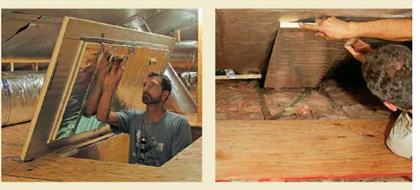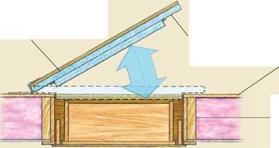Block the Biggest Offenders



![]()
![]()

![]()
![]()
![]()

 The attic access is a big leak that can be fixed quickly: Build or buy an insulated cover for the access bulkhead. The key is to provide a rim to connect to the sealing cover. The rim can be made from strips of sheathing, framing lumber, or rigid foam; then the cover sits on top or fits around the rim. On this job, I added a deck of leftover 1/2-in. plywood and OSB after the insulation was added.
The attic access is a big leak that can be fixed quickly: Build or buy an insulated cover for the access bulkhead. The key is to provide a rim to connect to the sealing cover. The rim can be made from strips of sheathing, framing lumber, or rigid foam; then the cover sits on top or fits around the rim. On this job, I added a deck of leftover 1/2-in. plywood and OSB after the insulation was added.
Interior soffits that are framed before the drywall is hung can leak huge quantities of air. Fill in the openings between the ceiling joists above the soffits with solid materials like rigid-foam panels, drywall pieces, or sheathing scraps, then seal the edges with expanding foam or caulk.
Joist bays should be sealed with rigid blocks to keep insulation where it belongs. Cut rigid foam into strips the width of the joist bays, and slip them out over the top wall plate (photo at top right). The panels block the loose – fill insulation that’s to be installed from clogging the soffit-to-ridge air channel and add a higher R-value to the short space over the plate.

layered batts can be tight together to minimize heat loss through the joists and to maximize performance.
If I’m upgrading to loose-fill insulation,
I keep it from falling into eave soffits and maintain channels for roof ventilation by installing a layer of blocking made from rigid insulation in the rafter (or truss) bays over the exterior-wall plates. I notch the rigid insulation around the rafters so that I get a tight fit in the bay.
Blowing Insulation is a Two-Person Operation
Blown-in loose-fill cellulose or fiberglass isn’t as common as batt insulation, but both are installed quickly and completely cover the attic floor. Loose fill can be blown in over any existing insulation that’s been tuned up first. Comparisons in R-value between the two are similar (around R-3.2 per in.). Over the first year, cellulose tends to






Leave a reply